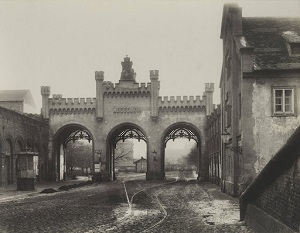
150 years ago, the demolition of the Prague fortifications began
 |
During his visit to Prague after the defeat in the war with Prussia in 1866, Austrian Emperor Franz Joseph I signed a decree that permanently changed the face of the capital city of the Kingdom of Bohemia. His decision to declare Prague an open city and thus abolish its fortification led to the demolition of the walls by the end of the 19th century and a sharp development of settlement around the five original Prague districts.
The walls had protected Prague from attacks since time immemorial, but they only rarely fulfilled their role, and as military arts evolved, they were, in fact, a relic by the second half of the 19th century. The last wave of fortification, namely the construction of the so-called New Walls, lasted about three-quarters of a century. Between 1650 and 1730, a belt of baroque fortifications tightened around Prague, which, rather than serving for defense against an enemy, ultimately facilitated easier collection of tolls from people heading into the city.
Moreover, the most recent fortifications were not very well executed from a military perspective. Several elevations, such as Vítkov or Letná, remained unprotected, from where the enemy could shell Prague with artillery. "The fortifications were built too simply... Perhaps only Vyšehrad can be rated as a fully-fledged citadel, particularly given its rather inaccessible terrain... However, its location on the southern edge of Prague significantly reduced its strategic value," writes historian Vladimír Kupka in the book Prague Fortifications.
The massive walls, some more than 12 meters high, measured 14 kilometers in length, from which three dozen bastions emerged, and in the 1860s, people could enter the city through ten gates. In addition to these, there was also a special railway gate that allowed trains to access the inner part of the first Prague railway station (today's Masaryk Station). However, at night, the city, just like in the Middle Ages, was still closed even in the middle of the previous century.
The walls not only restricted transport from the countryside to Prague (and vice versa) but also significantly limited the possibilities for the city's further expansion. For example, there was a regulation that "only temporary structures" could be built outside the fortifications "at the distance of a cannon shot," that is, about one kilometer, which the soldiers could have demolished in case of a threat. On the other hand, however, since the 1830s, the Prague walls began to be used for entirely non-military purposes as well.
Between 1827 and 1830, a five-meter-wide promenade was created on the part of the fortifications between Těšnov and the Koňská Gate at the upper part of Wenceslas Square. Sandy paths led under planted trees, among flowers and bushes. This part of the walls became a popular meeting place for the locals, who were served by two cafes for relaxation, in addition to pavilions, since the 1850s. It was in this area that new towns began to grow on the other side of the walls, namely Vinohrady (with later separated Žižkov) and Karlín.
The demolition of the walls around Prague was not an easy or inexpensive task, not least because the Austro-Hungarian treasury was now unwilling to give them up for free. However, Prague representatives were aware of how important the demolition of the fortified belt was for the development of the city, and they did not regret the money spent. After all, even in the early years of the operation of today's Main Railway Station, which opened in 1871, passengers had to first pass through the Koňská Gate before they could access it.
The English translation is powered by AI tool. Switch to Czech to view the original text source.
0 comments
add comment










